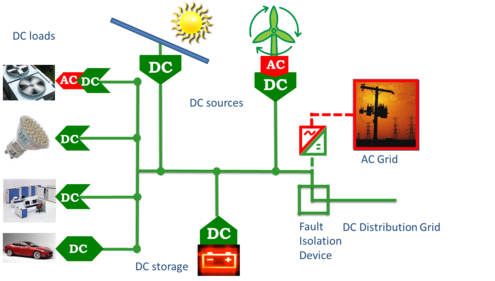Universal Direct Current Distribution System
Steps Towards the Universal Direct Current Distribution System

Project description
The traditional ac power system is challenged by increasing numbers of decentralized energy resources. In the extreme and most challenging case, power would be provided 100% by fluctuating renewable energies. Most of the distributed sources have a fluctuating behavior and as a consequence, demand response and/or storage will have to be used to keep the system operational. Moreover, the installed power capacity is increasing, e.g. due to electric vehicles, which will lead to more congestion in the distribution grid. The hypothesis in this project is that with a dc distribution system, these smart grid challenges can be solved more easily and more reliably than with ac distribution networks.
The war of currents between Edison with dc vs. Westinghouse and Tesla with ac was won by ac for good reasons a century ago. However as time passed and new developments were made, the foundations of this victory have become obsolete. Power electronics enable dc/dc conversion and in that way, allow the achievement of what hundred years ago only ac transformers could do properly: the change of voltage levels. From the high voltage side, HVdc lines are now used for long distance power transmission, as dc line losses are much smaller than ac ones. Other benefits achieved are the prevention of skin effects and a the reduction of problems related to cable capacitance, especially for sea cables.
However, also from the low voltage side, dc is having a comeback. Until now, this has taken place mostly inside the devices. First ac transformers were used to bring down the voltage to usual application levels, e.g. 20 V, and rectification was done thereafter. Nowadays ac transformers in devices are more and more being replaced by dc/dc converters. Due to their higher switching frequencies, typically 100 kHz instead of 50/60 Hz with ac, much smaller passive components can be used, which reduces size, weight and material costs. The ac from the grid needs therefore to be rectified and – to prevent distortion of the ac grid – artificial sinusoidal currents are drawn using power factor correction (PFC). Today even ac motors are more and more driven by motor controllers using ac/dc followed by dc/ac conversion, which allows variable speed control.
It is important to note that distributed renewable energy sources are mostly either dc inherently, e.g. photovoltaics, or use a dc link to decouple rotations speeds from the ac grid such as wind power. Furthermore, batteries are dc in general and their application is evolving in electric vehicles and other devices. For these reasons it is now plausible to consider bringing dc one level higher and as a consequence, to transform the distribution grid from ac to dc, eliminating dc/ac and ac/dc conversions. This is one of the main motivation for having dc distribution networks.
DC microgrids have the potential to improve reliability in the case of an outage occurring at a higher voltage level in the network by using available distributed sources and storage. For example, balancing local supply and demand and establishing financial compensation for grid losses could be done using the dc voltage. Due to the lack of synchronization requirements in dc, the reconnection to a higher level grid is straightforward. The centralized ac/dc conversion from low voltage or medium voltage ac grid is more efficient and can even help stabilize the ac grid, e.g. by supplying reactive power. The reduction of conversion steps and the lack of synchronization requirements motivate further research in dc distribution networks.
Our research focusses on finding the “best” low voltage dc microgrid system, implementing all smartgrid features needed in future. This can then be put into standards for a universal dc distribution system. Some points of interest are:
- New protection strategies for low voltage dc systems
- DC distribution system modularity and resilience
- Control of dc microgrids including demand response to allow 100% renewable energies
- Integration of real-time prosumer market models closely coupled to physical constraints